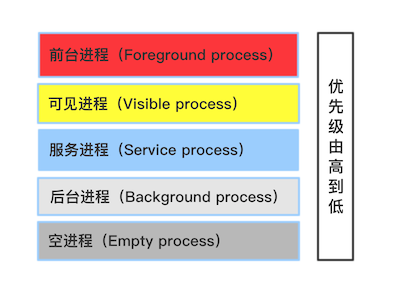Android进程优先级
在Android中将进程大致可以分为5类,前台进程、可见进程、服务进程、后台进程、空进程。如下图所示

前台进程:指正在与用户进行交互的应用进程,该进程数量较少,是最高优先级进程,系统一般不会终止该进程,而判断为前台进程的因素有以下这些
1、进程中包含处于前台的正与用户交互的activity;
2、进程中包含与前台activity绑定的service;
3、进程中包含调用了startForeground()方法的service;
4、进程中包含正在执行onCreate(), onStart(), 或onDestroy()方法的service;
5、进程中包含正在执行onReceive()方法的BroadcastReceiver.
可视进程:能被用户看到,但不能根据根据用户的动作做出相应的反馈,
1、进程中包含可见但不处于前台进程的activity(如:弹出对话窗时activity处于可见状态,但并不处于前台进程中)
2、该进程有一个与可见/前台的activity绑定数据的service
3、进程有一个startForeground的Service
服务进程:没有可见界面仍在不断的执行任务的进程,除非在可视进程和前台进程紧缺资源(如:内存资源)才会被终止
1、除前台进程和可视进程的service外的service的进程
后台进程:通常系统中有大量的后台进程,终止后台进程不会影响用户体验,随时为优先级更高的进程腾出资源而被终止,优先回收长时间没用使用过的进程。
1、一个进程只包含一个Application了
包含不在前台或可视进程的activity的进程,也就是已经调用onStop()方法后的activity
空进程:为提高整体系统性能,系统会保存已经完成生命周期的应用程序 ,存在与内存当中,也就是缓存,为下次的启动更加迅速而设计。通常会被定期地终止
查看进程优先级的方法
1、获取进程pid
> adb shell > ps | grep 包名
2、获取进程优先级
> cat proc/pid/oom_adj
通过读取oom_adj中的整数,我们就可以很清楚的明白进程所在的优先级。oom_adj的值越小,其优先级越高
这些值的具体定义在ProcessList.java这个文件中。
frameworks/base/services/java/com/android/server/am/ProcessList.java
/**
* Activity manager code dealing with processes.
*/
final class ProcessList {
// OOM adjustments for processes in various states:
// Adjustment used in certain places where we don't know it yet.
// (Generally this is something that is going to be cached, but we
// don't know the exact value in the cached range to assign yet.)
static final int UNKNOWN_ADJ = 16;
// This is a process only hosting activities that are not visible,
// so it can be killed without any disruption.
static final int CACHED_APP_MAX_ADJ = 15;
static final int CACHED_APP_MIN_ADJ = 9;
// The B list of SERVICE_ADJ -- these are the old and decrepit
// services that aren't as shiny and interesting as the ones in the A list.
static final int SERVICE_B_ADJ = 8;
// This is the process of the previous application that the user was in.
// This process is kept above other things, because it is very common to
// switch back to the previous app. This is important both for recent
// task switch (toggling between the two top recent apps) as well as normal
// UI flow such as clicking on a URI in the e-mail app to view in the browser,
// and then pressing back to return to e-mail.
static final int PREVIOUS_APP_ADJ = 7;
// This is a process holding the home application -- we want to try
// avoiding killing it, even if it would normally be in the background,
// because the user interacts with it so much.
static final int HOME_APP_ADJ = 6;
// This is a process holding an application service -- killing it will not
// have much of an impact as far as the user is concerned.
static final int SERVICE_ADJ = 5;
// This is a process with a heavy-weight application. It is in the
// background, but we want to try to avoid killing it. Value set in
// system/rootdir/init.rc on startup.
static final int HEAVY_WEIGHT_APP_ADJ = 4;
// This is a process currently hosting a backup operation. Killing it
// is not entirely fatal but is generally a bad idea.
static final int BACKUP_APP_ADJ = 3;
// This is a process only hosting components that are perceptible to the
// user, and we really want to avoid killing them, but they are not
// immediately visible. An example is background music playback.
static final int PERCEPTIBLE_APP_ADJ = 2;
// This is a process only hosting activities that are visible to the
// user, so we'd prefer they don't disappear.
static final int VISIBLE_APP_ADJ = 1;
// This is the process running the current foreground app. We'd really
// rather not kill it!
static final int FOREGROUND_APP_ADJ = 0;
// This is a system persistent process, such as telephony. Definitely
// don't want to kill it, but doing so is not completely fatal.
static final int PERSISTENT_PROC_ADJ = -12;
// The system process runs at the default adjustment.
static final int SYSTEM_ADJ = -16;
// Special code for native processes that are not being managed by the system (so
// don't have an oom adj assigned by the system).
static final int NATIVE_ADJ = -17;
}